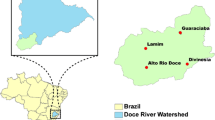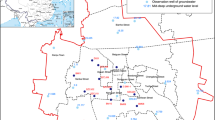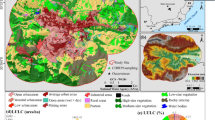Abstract
Land subsidence, exacerbated by excessive groundwater extraction, has become a critical environmental issue in many urban regions, posing risks to infrastructure stability and sustainable development. In this study, we aim to assess the land subsidence susceptibility of Liaocheng City, China, where rapid urbanization and agricultural demands have led to significant groundwater depletion. We hypothesize that groundwater depth and drawdown are the key drivers of subsidence, particularly in areas with thick clay layers and high extraction rates. To evaluate these factors, we integrate SBAS-InSAR technology with a novel combination of multi-criteria decision-making models, including extension theory and the normal cloud model, alongside subjective (AHP) and objective (CRITIC) weighting methods. Our results reveal distinct spatial patterns of subsidence risk. While most areas exhibit low to moderate susceptibility, Guan County and Xin County show heightened vulnerability, with subsidence exceeding 100 mm over the study period, driven by intensive groundwater extraction and unfavorable geological conditions. In contrast, regions like Dongchangfu District and Gaotang County exhibit low susceptibility, due to effective groundwater management and favorable soil characteristics. The application of extension theory and the normal cloud model provides a refined risk classification, offering detailed insights into the spatial distribution of subsidence risks. These findings emphasize the need for targeted groundwater management policies in high-risk areas and demonstrate the effectiveness of the proposed framework for evaluating subsidence susceptibility. This study contributes a novel, data-driven approach to subsidence risk assessment, with implications for sustainable urban planning and resource management.






Similar content being viewed by others
Explore related subjects
Discover the latest articles and news from researchers in related subjects, suggested using machine learning.Data availability
No datasets were generated or analysed during the current study.
References
Alanazi MA, Ali I (2024) Simulations and analysis of underwater acoustic wave propagation model based on Helmholtz equation. Appl Math Sci Eng 32(1). https://doi.org/10.1080/27690911.2024.2338397
Arabameri A, Santosh M, Rezaie F, Saha S, Costache R, Roy J et al (2022) Application of novel ensemble models and k-fold CV approaches for land subsidence susceptibility modelling. Stoch Env Res Risk Assess 36(1):201–223. https://doi.org/10.1007/s00477-021-02036-7
Azarakhsh Z, Azadbakht M, Matkan A (2022) Estimation, modeling, and prediction of land subsidence using Sentinel-1 time series in Tehran-Shahriar plain: A machine learning-based investigation. Remote Sens Appl Soc Environ 25. https://doi.org/10.1016/j.rsase.2021.100691
Babaee S, Khalili MA, Chirico R, Sorrentino A, Di Martire D (2024) Spatiotemporal characterization of the subsidence and change detection in Tehran plain (Iran) using InSAR observations and Landsat 8 satellite imagery. Remote Sens Appl Soc Environ 36. https://doi.org/10.1016/j.rsase.2024.101290
Chao J, Yue Y, Xiao Y, Xiaowei Z (2022) Research on risk of ground subsidence induced by groundwater exploitation in linear engineering. Yangtze River 53(12):104–110, 156. https://doi.org/10.16232/j.cnki.1001-4179.2022.12.016
Chen W, Xiao W, He T, Ruan L, Zhao Y, Hu Z (2024) Quantify the extensive crop damage and grain losses caused by underground coal mining subsidence in eastern China. J Clean Prod 469. https://doi.org/10.1016/j.jclepro.2024.143204
Chitsazan M, Rahmani G, Ghafoury H (2022) Land subsidence susceptibility mapping using PWRSTFAL framework and analytic hierarchy process : fuzzy method ( case study : Damaneh-Daran Plain in the west of Isfahan Province , Iran ). Environ Monitor Assess 194(3). https://doi.org/10.1007/s10661-021-09645-3
Du Q, Chen D, Li G, Cao Y, Zhou Y, Chai M et al. (2023). Preliminary study on InSAR-based uplift or subsidence monitoring and stability evaluation of ground surface in the permafrost zone of the Qinghai-Tibet engineering Corridor, China. Remote Sens 15(15). https://doi.org/10.3390/rs15153728
Eshmawi MT, Al-Mudaiheem HY, Fatani M, Binamer Y, Alajlan M, Alharithy R et al. (2024). Expert consensus on unmet needs, referral criteria and treatment goals for hidradenitis suppurativa in Saudi Arabia. J Dermatol Treat 35(1). https://doi.org/10.1080/09546634.2024.2353693
Hishammuddin MAHB, Wang J, Wu F, Ismail MAB, Abidin HZ, Siong HC et al. (2024) Scenario spatial planning evaluation model for subsidence -economic resilience environment in geohazard prone-coastal megacities: urban underground space (UUS) development in Shanghai by year 2035. Environ Earth Sci 83(16). https://doi.org/10.1007/s12665-024-11763-3
Huang R, He H, Su Q (2024) An intelligent full-knowledge transferable collaborative eco-driving framework based on improved soft actor- critic algorithm. Appl Energy 375. https://doi.org/10.1016/j.apenergy.2024.124078
Imai K, Nakai K, Hirai T, Noda T, Arai N, Iwama S et al (2024) Tsunami hazard evaluation of river embankment structures incorporating their vulnerability to seismic strong motion. Earthq Spectra 40(3):2008–2037. https://doi.org/10.1177/87552930241237815
Jang J, Lee J, Redwan M, Raza M, Lee M, Oh S (2023) Hydrogeological characteristics and water chemistry in a coastal aquifer of Korea : implications for land subsidence. Environ Monit Assess 195(11). https://doi.org/10.1007/s10661-023-11926-y
Jia C, Zhang Y, Han J, Xu X (2017) Susceptibility area regionalization of land subsidence based on extenics theory. Cluster Comput J Netw Softw Tools Appl 20(1):53–66. https://doi.org/10.1007/s10586-016-0720-4
Kalavrezou I, Castro-Melgar I, Nika D, Gatsios T, Lalechos S, Parcharidis I (2024) Application of Time Series INSAR ( SBAS ) method using sentinel-1 for monitoring ground deformation of the Aegina Island (Western Edge of Hellenic Volcanic Arc). Land 13(4). https://doi.org/10.3390/land13040485
Kharal S, Siddique F, Arshad M, Aziz N, Khalid W, Khalid MZ et al (2024) Comparative analysis of phytochemical compounds, antioxidant potential, and in vitro antibacterial activity of Zahidi date parts from Pakistan. Int J Food Prop 27(1):799–814. https://doi.org/10.1080/10942912.2024.2365924
Khattak AJ, Hamm A (2024) Limited control of microtopography evolution on ground subsidence in polygonal tundra landscapes. Sci Total Environ 948. https://doi.org/10.1016/j.scitotenv.2024.174741
Kumar P, Kumar S, Alkahtani BST, Alzaid SS (2024) The complex dynamical behaviour of fractal-fractional forestry biomass system. Appl Math Sci Eng 32(1). https://doi.org/10.1080/27690911.2024.2375542
Li D, Liu C (2004) Study on the universality of the normal cloud model. Eng Sci
Li H, Chen M (2023) Time series clustering based on normal cloud model and complex network. Appl Soft Comput 148. https://doi.org/10.1016/j.asoc.2023.110876
Li Y, Zhang X, Huang Q, Pathera D, An Z, Jiao X et al. (2024) Improving smallholders' capacity building by creating an enabling environment for sustainable crop production. Agric Syst 220. https://doi.org/10.1016/j.agsy.2024.104083
Lu X, Su P, Chen M, Qiu P, Li Y, Ding H et al. (2024b) Study on influencing factors and mechanism of land subsidence in delta resource exploitation area of Shengli oilfield. Environ Earth Sci 83(9). https://doi.org/10.1007/s12665-024-11580-8
Lu Y, Li T, Deng Y (2024a) Predication of Water Pollution Peak Concentrations by Hybrid BP Artificial Neural Network Coupled with Genetic Algorithm. Appl Artif Intell 38(1). https://doi.org/10.1080/08839514.2024.2341356
Lyu H, Shen S, Zhou A, Yang J (2020) Risk assessment of mega-city infrastructures related to land subsidence using improved trapezoidal FAHP. Sci Total Environ 717. https://doi.org/10.1016/j.scitotenv.2019.135310
Mautner MRL, Herman JD (2024) Evaluating aquifer management objectives against socioeconomic indicators to understand differential impacts on communities across multiple scales. J Water Resour Plann Manage 150(10). https://doi.org/10.1061/JWRMD5.WRENG-6415
Ong DEL, Jong SC, Cheng WC (2022) Ground and groundwater responses due to shaft excavation in organic soils. J Geotech Geoenviron Eng 148(8). https://doi.org/10.1061/(ASCE)GT.1943-5606.0002820
Pu J, Huang Y, Bi Y, Guo Z, Deng F, Li X et al (2024) 3D suitability evaluation of urban underground space using a variable weight method and considering ground restrictions. Underground Space 19:208–226. https://doi.org/10.1016/j.undsp.2023.12.004
Ramirez-Serrato NL, Garcia-Cruzado SA, Herrera GS, Yepez-Rincon FD, Villarreal S (2024) Assessing the relationship between contributing factors and sinkhole occurrence in Mexico City. Geomat Natural Hazards Risk 15(1). https://doi.org/10.1080/19475705.2023.2296377
Salem HSA, Fallah OAE, Kammar MME (2024) Hydrochemical study of groundwater in Tazerbo, Libya, using statistical analysis and geochemical modeling. J Afr Earth Sci 218. https://doi.org/10.1016/j.jafrearsci.2024.105362
Segbenya M, Senyametor F, Aheto SK, Agormedah EK, Nkrumah K, Kaedebi-Donkor R (2024) Modelling the influence of antecedents of artificial intelligence on academic productivity in higher education: a mixed method approach. Cogent Educ 11(1). https://doi.org/10.1080/2331186X.2024.2387943
Shi M, Gao M, Chen Z, Lyu M, Gong H, Zhai Y et al. (2024). Land subsidence in Beijing: response to the joint influence of the South-to-North water diversion project and ecological water replenishment, observed by satellite radar interferometry. Gisci Remote Sens 61(1). https://doi.org/10.1080/15481603.2024.2315708
Sivamayilvelan K, Rajasekar E, Vairavasundaram S, Balachandran S, Suresh V (2024) Flexible recommendation for optimizing the debt collection process based on customer risk using deep reinforcement learning. Expert Syst Appl 256. https://doi.org/10.1016/j.eswa.2024.124951
Song S, Mei S, Hu Y, Li Q, Chen Z, Zhang S (2024) Research on the thermo-hydro-mechanical coupling simulation and deformation spatiotemporal evolution for the entire process of oil shale in-situ mining. Eng Geol 339. https://doi.org/10.1016/j.enggeo.2024.107643
Srivastava MK, Gaur S, Ohri A (2024) Analysing the effectiveness of MCDM and integrated weighting approaches in groundwater quality index development. Water Conserv Sci Eng 9(2). https://doi.org/10.1007/s41101-024-00267-7
Sun Y, Zhan J, Qiang F, Lu Q, Liu C, Yao Z et al. (2024) Spatio-temporal evolution of land subsidence and susceptibility zonation of associated ground fissures in the urban area of loess plateau: a case in Xianyang city, China. Geomat Natural Hazards Risk 15(1). https://doi.org/10.1080/19475705.2024.2341181
Thieblemont R, Le Cozannet G, Nicholls RJ, Rohmer J, Woppelmann G, Raucoules D et al. (2024). Assessing current coastal subsidence at continental scale: Insights from Europe using the European ground motion service. Earths Future 12(8). https://doi.org/10.1029/2024EF004523
Wahyudi PA, Purwanto P, Putranto TT (2020) Analysis of correlation between bearing capacity of the land against land settlement and duration of decline in Semarang city. Intl J Geomate 19(73):163–169. https://doi.org/10.21660/2020.73.57306
Wang R, Huang S, He Y, Wu K, Gu Y, He Q et al. (2024c) Construction of high-precision and complete images of a subsidence basin in sand dune mining areas by InSAR -UAV-LiDAR heterogeneous data integration. Remote Sens 16(15). https://doi.org/10.3390/rs16152752
Wang Y, Fan R, Yan J, Jin M, Lei X, Wang Y et al. (2024b) An analysis of urban land subsidence susceptibility based on complex network. Natural Hazardshttps://doi.org/10.1007/s11069-024-06815-7
Wang Z, Lv B, Li J, Yin S (2024a) Geothermal energy extraction-induced ground movement monitoring by InSAR and its implication for reservoir management. J Energy Eng 150(5). https://doi.org/10.1061/JLEED9.EYENG-5523
Xu M, Pan W (2024) Informative design exploration of tower building geometry typology and solar potential using SOM- MLPNN with generalized form-description-based parametric modelling. J Build Eng 95. https://doi.org/10.1016/j.jobe.2024.110114
Yan J, Ren K, Wang T (2024) Improving multidimensional normal cloud model to evaluate groundwater quality with grey wolf optimization algorithm and projection pursuit method. J Environ Manage 354. https://doi.org/10.1016/j.jenvman.2024.120279
Yananto A, Yulianto F, Wibowo M, Rahili N, Perdana DHF, Wiguna EA et al. (2024) Integration Sentinel-1 SAR data and machine learning for land subsidence in-depth analysis in the North Coast of Central Java, Indonesia. Earth Sci Inform. https://doi.org/10.1007/s12145-024-01413-4
Yang X, Jia C, Sun H, Yang T, Yao Y (2024a) Integrating multi-source data to assess land subsidence sensitivity and management policies. Environ Impact Assess Rev 104. https://doi.org/10.1016/j.eiar.2023.107315
Yang X, Yao Y, Jia C, Yang T (2024b) Spatiotemporal prediction of land subsidence and its response patterns to different aquifers in coastal areas. Ocean Coast Manage 253. https://doi.org/10.1016/j.ocecoaman.2024.107148
Zeng Y, Li J, Zheng Y, Zhang D, Zhong N, Zuo X et al. (2024). Development and validation of a predictive model for submucosal fibrosis in patients with early gastric cancer undergoing endoscopic submucosal dissection: experience from a large tertiary center. Ann Med 56(1). https://doi.org/10.1080/07853890.2024.2391536
Zhang J, Kou P, Tao Y, Jin Z, Huang Y, Cui J et al. (2024) Urban ground subsidence monitoring and prediction using time-series InSAR and machine learning approaches: a case study of Tianjin, China. Environ Earth Sci 83(16). https://doi.org/10.1007/s12665-024-11778-w
Zhang Z, Zhang S, Hu C, Zhang X, Yang S, Yan H et al (2023) Hazard assessment model of ground subsidence coupling AHP, RS and GIS - A case study of Shanghai. Gondwana Res 117:344–362. https://doi.org/10.1016/j.gr.2023.01.014
Zhong X, Gong H, Chen B, Zhou C, Xu M (2024). Study on the evolution of shallow groundwater levels and its spatiotemporal response to precipitation in the Beijing Plain of China based on variation points. Ecol Indic 166. https://doi.org/10.1016/j.ecolind.2024.112466
Zhu Y, Sun D, Wen H, Zhang Q, Ji Q, Li C et al. (2024). Considering the effect of non-landslide sample selection on landslide susceptibility assessment. Geomat Natural Hazards Risk 15(1). https://doi.org/10.1080/19475705.2024.2392778
Funding
This research was supported by the Special Foundation of Shandong Engineering Research Center for Groundwater Environmental Protection and Remediation (No.801KF2022-7).
Author information
Authors and Affiliations
Contributions
Yunfeng Zhang: conceptualization, analysis, writing—original draft. Xueyang Hu: methodology, interpretation of data, writing—original draft. Zhiqiang Zhao: formal analysis, data curation, writing—review, and editing. Shuai Gao: formal analysis, writing—review and editing. Minghui Lv: formal analysis, writing—review and editing. Chao Jia: supervision, project administration, writing—review and editing. Xiao Yang: supervision, project administration, methodology, writing—original draft, writing—review and editing, visualization.
Corresponding authors
Ethics declarations
Ethical approval
This article does not contain any studies with human participants or animals performed by any of the authors.
Competing interests
The authors declare no competing interests.
Additional information
Communicated by Hassan Babaie.
Publisher's Note
Springer Nature remains neutral with regard to jurisdictional claims in published maps and institutional affiliations.
Rights and permissions
Springer Nature or its licensor (e.g. a society or other partner) holds exclusive rights to this article under a publishing agreement with the author(s) or other rightsholder(s); author self-archiving of the accepted manuscript version of this article is solely governed by the terms of such publishing agreement and applicable law.
About this article
Cite this article
Zhang, Y., Hu, X., Zhao, Z. et al. Revealing hidden risks: advanced assessment of urban land subsidence. Earth Sci Inform 18, 342 (2025). https://doi.org/10.1007/s12145-025-01847-4
Received:
Accepted:
Published:
DOI: https://doi.org/10.1007/s12145-025-01847-4




